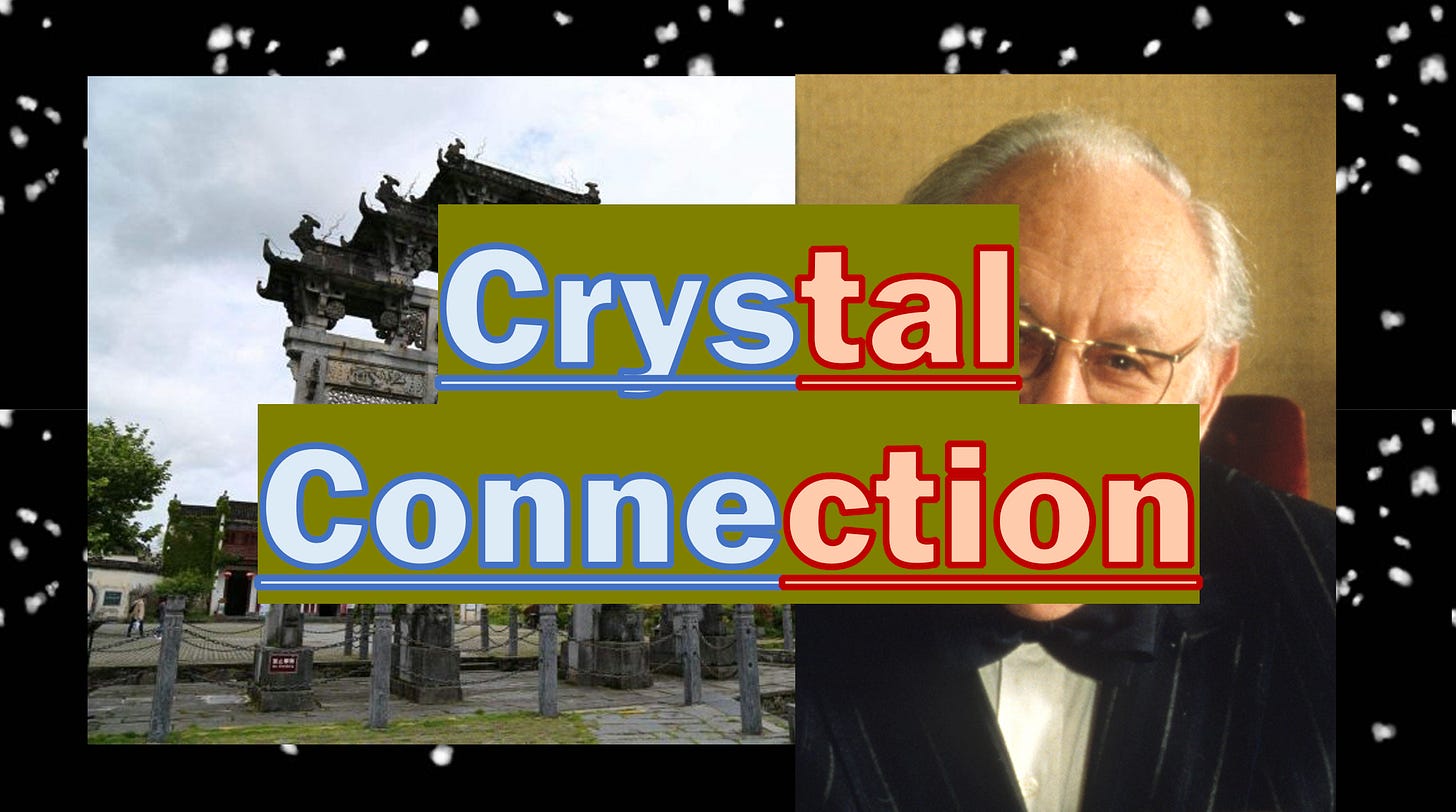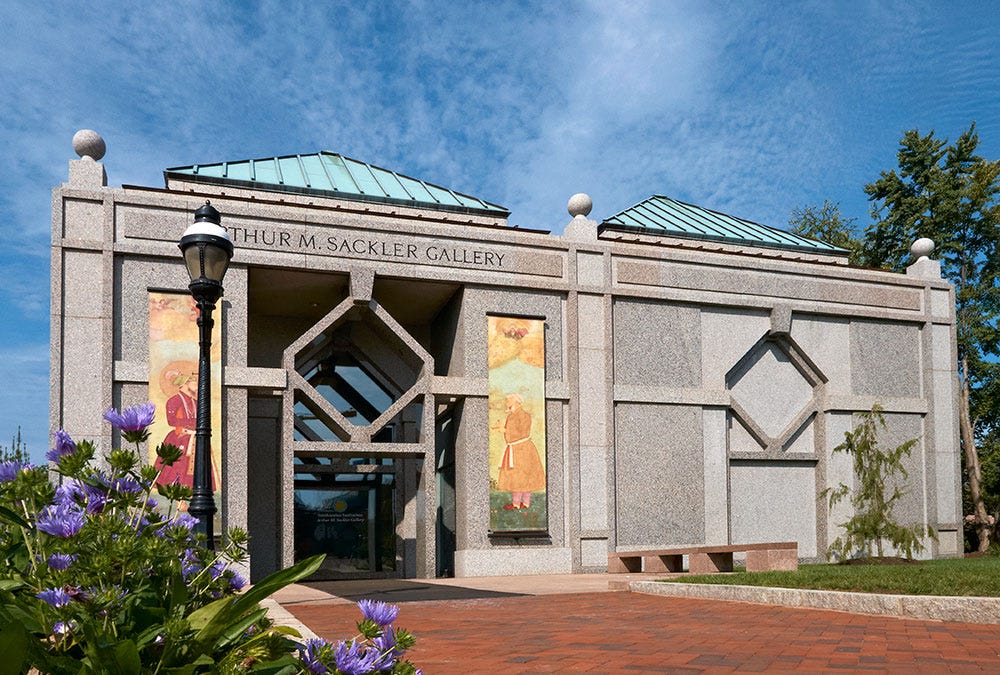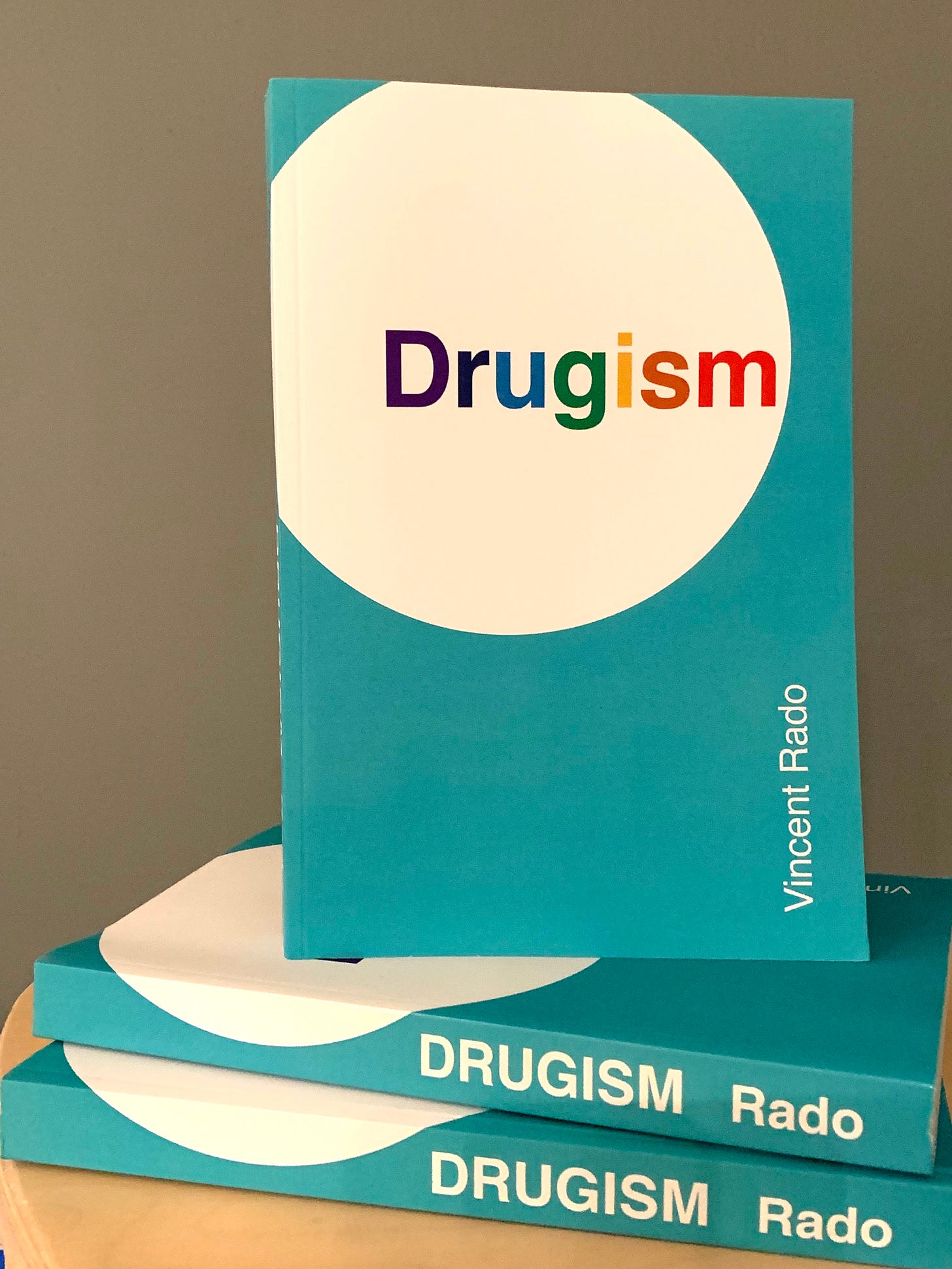An archway financed by a Ming Dynasty Huizhou merchant, left; Arthur Sackler, right; in background, salt crystals. See photo credits below.
The following is an excerpt from p. 58-61 of Chapter 1, “Precious Crystals: What Salt Teaches Us About Drugs” from my new book, Drugism (2022):
[This excerpt is the 2nd in a 4-part series exploring the parallels between history’s salt merchants and today’s drug dealers, both legal and illegal. Read Part 1 here.]
3. Social alliance among industry, state, and scholars
For such a revolving door, so to speak, to be successful, some type of solidarity among the parties involved is helpful. This brings is to our third major similarity between history’s salt merchants and today’s pharmaceutical executives: social and ideological alliance among merchants, scholars, and the state. Cozy friendship with government officials and academic figures has proven to be fruitful for various players in the private sector, not least among which have been salt magnates and drug tycoons.
But this tidy alliance has not existed forever. For an extended period in Chinese history before the rise of modern global mercantilism, commercial trade was generally looked down upon. Business was considered less noble than political affairs and morally ambiguous in a way that other traditional kinds of labor were not. As a result, scholars and imperial politicians strove to distinguish themselves from merchants.[i] By the eighteenth century, however, much of this enmity had turned into admiration.
This was due in large part to scholars’ and merchants’ shared connection to the imperial court. As Wu explains, the day-to-day operations of the Chinese empire in this period were integrally dependent on the scholarship of elite academics.[ii] Since the merchants were themselves dependent on the imperial court, in was in each party’s interest to align themselves ideologically and socially. As the merchant class (itself dominated by salt merchants) gained more power, its members joined the ranks of bureaucrats and scholars.
Cozy friendship with government officials and academic figures has proven to be fruitful for various players in the private sector, not least among which have been salt magnates and drug tycoons.
As a result, imperial Chinese academia shifted from dismissing merchants’ ways to studying and promoting them. By roughly the eighteenth century, the same crass business techniques which had been shunned years earlier became the celebrated subject of academic discourse.[iii] The techniques used by the most cunning, profitable merchants now provided the basis of business education, imperial policy, and the like. And a similar phenomenon has occurred in the modern US: corporations, academia, and the state have aligned themselves to varying degrees.
As business affairs gained public respect in China, merchants themselves started to become more highly educated. Perhaps more importantly, they also began to sponsor and patronize professional scholars. The scholars who received such support were those whose work promoted the agendas and public image of the merchants. The resulting dynamic fostered an academic atmosphere which was conducive to business interests. Wealthy salt merchants also donated large sums of money and resources to various educational endeavors. They strove to include education as part of their legacy.[iv]
In the modern US, just as in Qing-era China, commerce has a tight grip on academia. A sizeable portion of scholars are beholden to those with deeper pockets than their own—people such as the Sackler family. In many ways, the Sackler family’s experience with and influence in educational institutions greatly resembles that of the imperial Chinese salt merchants. This is the third similarity between salt and drug merchants.
In the modern US, just as in Qing-era China, commerce has a tight grip on academia.
Although he came from a working-class background, Arthur Sackler was able to obtain two degrees from New York University. He also helped his brothers get accepted into medical schools and paid for their professional training.[v] Not only were the Sacklers well-situated within the world of academia; Purdue, their corporation, was as well.
Just as China’s Qing-era salt merchants subsidized the work of academics friendly to their cause, Purdue and other pharmaceutical companies have done the same. Purdue poured millions of dollars into think tanks like the one operated by David Joranson, a University of Wisconsin scientist whose work was used to promote Purdue’s opioids. Or consider Russel Portenoy, a doctor and scientist who received funds from pharmaceutical companies such as Purdue to give presentations and subsequently endorsed their drugs. Portenoy also published numerous studies which downplayed the risks of opioid use and which were used as intellectual ammunition by Purdue and others.[vi]
Such commercially-inspired scientific “consensus” has directly influenced governmental affairs, both in imperial China and the modern US.[vii] Transaction-minded theory came to influence statecraft in China in the same period in which the salt merchants saw a rapid growth of power. Similarly, in more recent years, academic findings backed by Purdue and other pharmaceutical companies have managed to shape public policy.
In the 1990s, for example, pro-opioid research backed by Purdue influenced the US Public Health Service’s (USPHS) approach to opioids. The USPHS encouraged healthcare professionals to administer opioids more widely than they had been, based on findings presented by folks like Portenoy and Joranson. The same findings were used to lobby Congress not to pass a law which would have established a prescription monitoring service under the control of the federal government.[viii] Clearly, the academic work subsidized by pharmaceutical companies like Purdue has had an enormous impact on US governmental affairs.
And, like imperial China’s salt merchants, modern pharmaceutical barons have donated enormous sums to various educational institutions. The Sacklers alone have contributed to Harvard University and Columbia University in the US, the University of Sussex and the University of Oxford in the UK, Peking University in China, and more.[ix] Some of these institutions even have buildings named after the Sacklers. This brings us to our fourth similarity between history’s salt merchants and today’s drug barons: enormous displays of wealth.
4. Large, public displays of wealth and legacy
Just like modern pharmaceutical executives, imperial China’s salt merchants demonstrated their commercial success by financing the construction of buildings dedicated to themselves and their families. Wu explains that such buildings served as symbols to strengthen the merchants’ connections with scholars, officials, and local populations. They lent prestige to the merchants’ reputation—or at least, that was the hope. Pharmaceutical tycoons like the Sacklers have taken up the same practice. But for them it has backfired. Multiple buildings named after the family have seen protests as backlash to their aggressive opioid marketing.[x]
5. Art collector identity
The final, and most specific, trait shared by salt merchants and pharmaceutical executives that we will examine is the pursuit of art collector identity. As Wu writes, many wealthy salt merchants in Qing-era China spent considerable amounts of money to collect art, antiques, and books. They also patronized artists.[xi]
Art collection plays a similar role to the buildings discussed above. Both serve functions beyond their obvious initial meaning. Just as notable buildings in a family name help shape the family’s public image, wealthy merchants have used art collecting “to construct their social identity and to strengthen connections with the [government].”[xii] Wu writes that
wealthy salt merchants’ devotion in collection can be understood as their effort to build a self-image as a collector, an identity with which they could identify themselves and that could be recognized and remembered.[xiii]
More bluntly, art collection is a pleasant distraction from the mundane source of the wealth which often pays for it. It is also a hobby that one can hardly indulge in without a considerable degree of expendable income. The rise of art collecting as an elite hobby in Qing-era China is one of the “social trends” which, as noted by Wu, “bear[s] a revealing resemblance to counterparts in early modern Europe” and, we might add, the present-day US.[xiv]
Arthur Sackler similarly pursued art collecting and patronage. The wealth made from his company’s drug sales went on to fund numerous art galleries around the world from New York to Beijing. Some have since removed the Sackler name in light of Purdue’s legal trouble; others are considering it.[xv] Nonetheless, art is very much a part of the Sackler legacy. Art collection is embraced by folks like the Sacklers in much the same way that it was by history’s wealthiest salt merchants.
In my studies, I even found a particular family in China’s imperial salt trade whose story greatly resembles that of the Sacklers. They are the Bao family. Within these families, the position of Arthur Sackler loosely compares to that of Bao Zhidao. Born into a family of merchants, Bao Zhidao used his success in the salt industry to elevate his family socially and economically. As a result of his enormous success, his family was able to develop close relationships with the imperial government.[xvi]
The Bao family also used their wealth to support the work of various scholars, not unlike the Sacklers. They even financed the construction of a large arch to memorialize their family’s success.[xvii] At this, the Sacklers have the Baos easily beat, however, with the numerous buildings across the globe which have been paid for and named after them.
A more specific and rather ironic similarity between the two families is that both have been charged with breaking the law in the course of their business.[xviii] In each case, the legal trouble occurred years after the passing of the family patriarchs, Bao Zhidao and Arthur Sackler, respectively. With this we see clearly just how similar the lives and business of today’s drug barons are to history’s salt merchants.
Arguably, history’s salt barons and today’s pharmaceutical executives have more in common than not. In the pages above we have seen five, distinct similarities: merchants’ unique class status; revolving door relationships with their respective governments; social and ideological alliance among merchants, scholars, and government; large, public displays of wealth; and art collection and patronage.
Until now, however, our discussion has focused on legal salt merchants and legal drug tycoons. What if we look at the lives of illegal salt and drug merchants? They, it turns out, have as much or more in common than their legal counterparts.
[Read Part 3 here.]
Endnotes
[i] Wu, 12-13.
[ii] Ibid., 21.
[iii] Ibid.
[iv] Ibid., 6, 105, 153 and 155.
[v] Meier, 46 and 53.
[vi] On Joranson, see Meier, 122; on Portenoy, see ibid., 22, 31-32.
[vii] Wu, 21; Meier, 35.
[viii] Meier, 35 and 37.
[ix] Ibid., 46; Rado, 121.
[x] Wu, 23, 185; Cascone, “After Purdue Pharma…”
[xi] Wu, 23, 188.
[xii] Ibid., 124.
[xiii] Ibid., 191.
[xiv] Ibid., 24.
[xv] Meier, 46, 60 and 61; Cascone.
[xvi] Wu, 129 and 132.
[xvii] Ibid., 131 and 155.
[xviii] Ibid., 132.
Sources
Cascone, Sarah. “After Purdue Pharma Reached a $225 Million Settlement With US Authorities, the Met Says the Name of Its Sackler Wing Is ‘Under Review.’” Artnet News, Oct 23, 2020.
Meier, Barry. Pain Killer: An Empire of Deceit and the Origin of America’s Opioid Epidemic. Random House. New York, NY. 2018 [originally published in 2003].
Rado, Vincent. we’re here, we’re high. 2018.
Wu, Yulian. Luxurious Networks: Salt Merchants, Status, and Statecraft in Eighteenth-Century China. Stanford University Press. Stanford, CA. 2017.
Photo credits
Photo of Huizhou archway from 刘闲人 on Trip.com at https://us.trip.com/travel-guide/attraction/yi-county/hu-wenguang-memorial-archway-96640/
Photo of Arthur Sackler from Wikidata at https://www.wikidata.org/wiki/Q4799609
Photo of falling salt from Shutterstock at https://www.shutterstock.com/video/clip-1012493837-salt-falling-above-on-black-background-4k
#drugism #drugs #drug #salt #opioid #opioids #oxycodone #capitalism #drugpolicy #history #sociology








